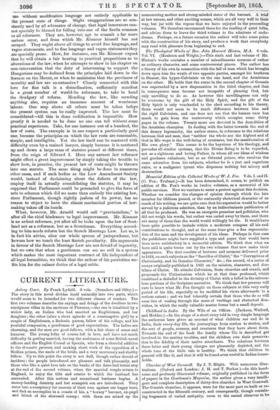Churches of West Cornwall. By J. T. Blight. With numerous
illus- trations. (Oxford and London : J. H. and T. Parker.)—In this hand- some and profusely illustrated volume, originally published in the form of papers in the Gentleman's Magazine, the author gives a very intelli- gent and con:Li:late description of thirty-five churches in West Cornwall. The Cornish churches, it appears, were for the most part re-built or re- constructed in the fifteenth century, and consequently, though contain- ing fragments of varied antiquity, seem to the casual observer to be fashioned after one model, and to belong to one style, the perpendicular, modified from local causes, and principally by the employment of granite as the material of construction. This is fatal to delicacy of workman- ship, and such sculpture as was attempted has been reduced to shapeless masses, but the "plain granite towers harmonize well with the wild and exposed country in which they are situated." The author gives an in- teresting account of the ancient oratories of the county ; they are very numerous, and appear to have been constructed originally of very simple materials by Irish missionaries in the early days of British Christianity. When these crumbled away, in order to keep alive the memory of the saints who had inhabited them, dry stone walls were erected on the original plans, and the buildings were continued in use as chapels and baptisteries. The volume concludes with a chapter on general Cornish antiquities, which resulted from a visit of the Cambrian Archaeological Association, to whom the author did the honours of Cornwall as their corresponding secretary. It contains an account of the caves or earth- huts, connected with early British life, and of the many kinds of antique stones, cromlechs, menhirs, &c., in which the county abounds. Admi- rable engravings of these accompany the letter-press ; indeed the author has included in his sketches everything that is noticeable, from the man- an-tol, i.e., stone with a hole through it, or bit of quaint rood-screen, or pillar-capital, to the more elaborate designs of chancel, cloister, and tower, and sometimes a pretty picture of the church itself and the surrounding scenery. We can warmly recommend the book, which, with its well- arranged matter and capital engravings, constitutes a valuable addition to English ecclesiology.































 Previous page
Previous page